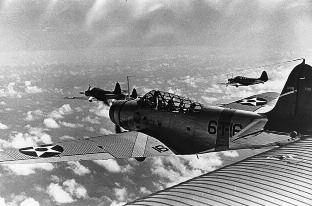Jack Waldron
Lt. Cdr. Jack Waldron was the only experienced pilot in his squadron. He had graduated from the Naval Academy in 1924 to become a naval aviator. At Midway he commanded Torpedo Squadron 8 aboard the USS Hornet . Early on June 4 he knew that their first combat action was imminent. He briefed his aircrew with prophetic words: “I want each of us to do his utmost to destroy our enemies. If there is only one plane left to make a final run, I want that man to go in and get a hit. May God be with us all.”71
He knew that his men were piloting obsolete aircraft. Top speed for his fifteen TBD Devastators was two hundred miles per hour, compared with three hundred fifty for the Japanese Zeros. Not a man in his squadron had ever carried a torpedo in his aircraft, much less flown off a carrier with one. Their training had consisted mainly of “chalkboard” exercises. Even with all these disadvantages, however, Waldron knew that he and his men faced one of those grave, historic moments that found a few men in a desperate but vital role. They had to do whatever was humanly possible. One hit on an enemy carrier might make all the difference.
Jack Waldron exemplified great leadership in a crisis situation. One of his pilots said of him later: “I know that if I had it all to do over again, even knowing that the odds were going to be like they were, knowing him like I did know him, I’d follow him again through exactly the same thing because I trusted him…”72 This kind of trust is built over time by a leader who puts the needs of those under him ahead of his own. The model of this servant attitude was Jesus Christ.
The greatest among you should be like the youngest, and the one who rules like the one who serves.
—Luke 22:26

TBD Devastator torpedo bombers in formation. (U.S. Naval Historical Center)

SBD Dauntless dive bomber. (U.S. Dept. of Defense) (public domain photo from militaryfactory.com)